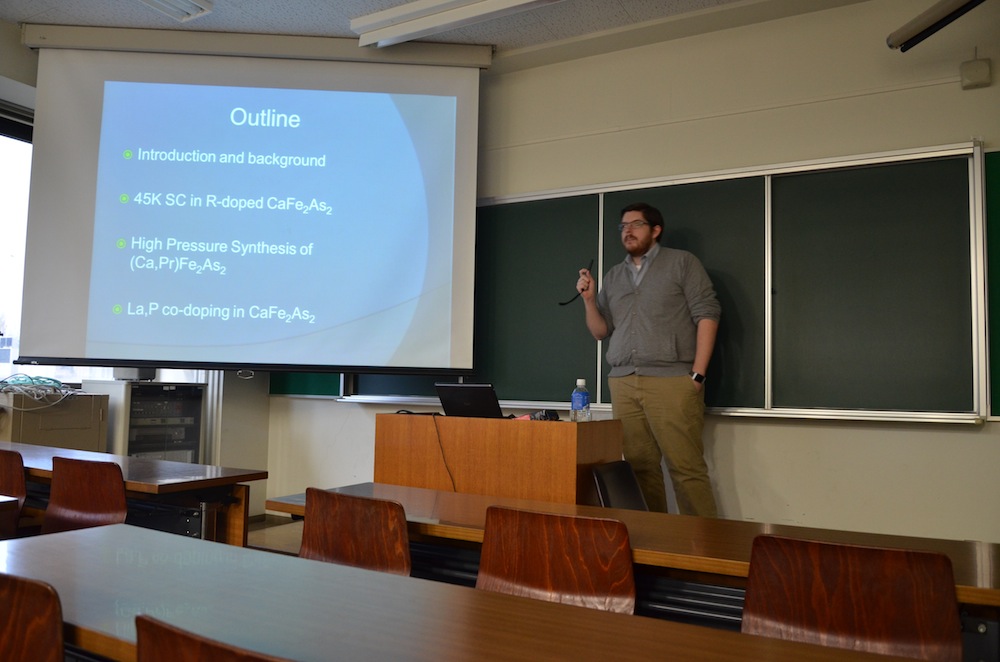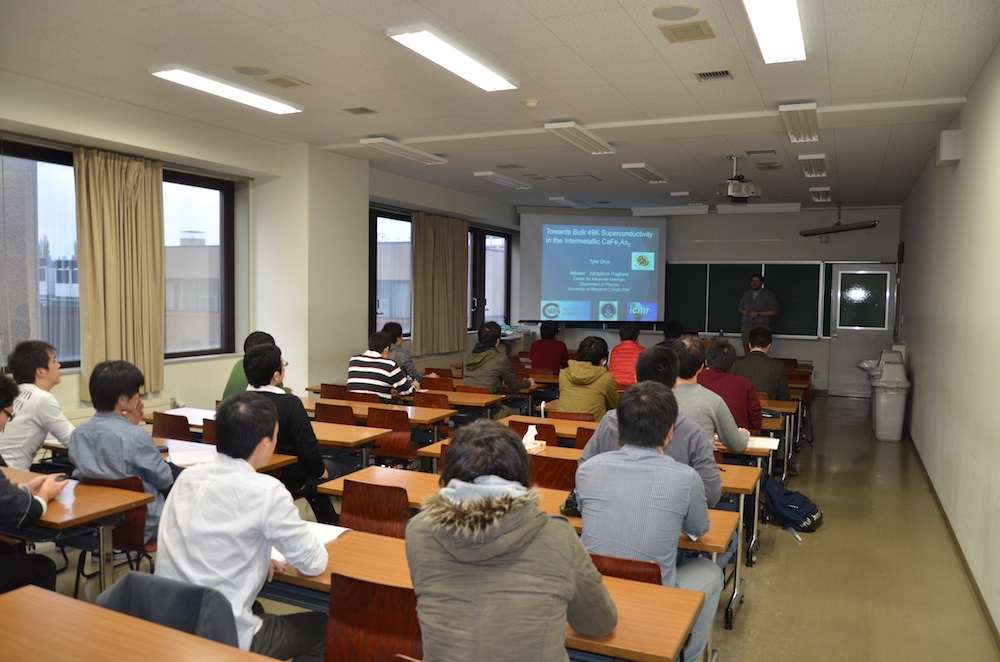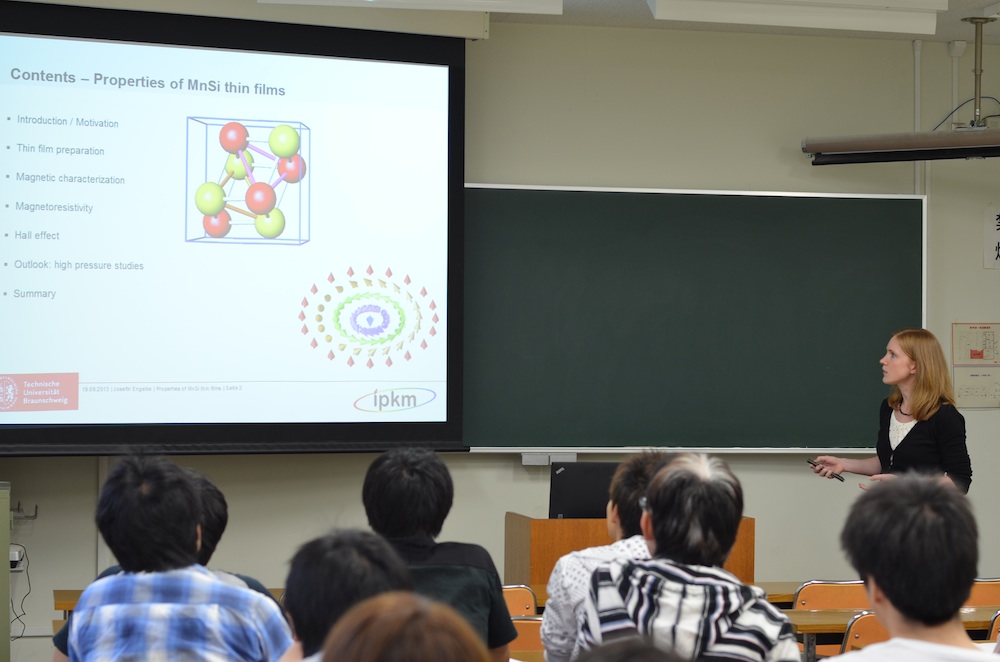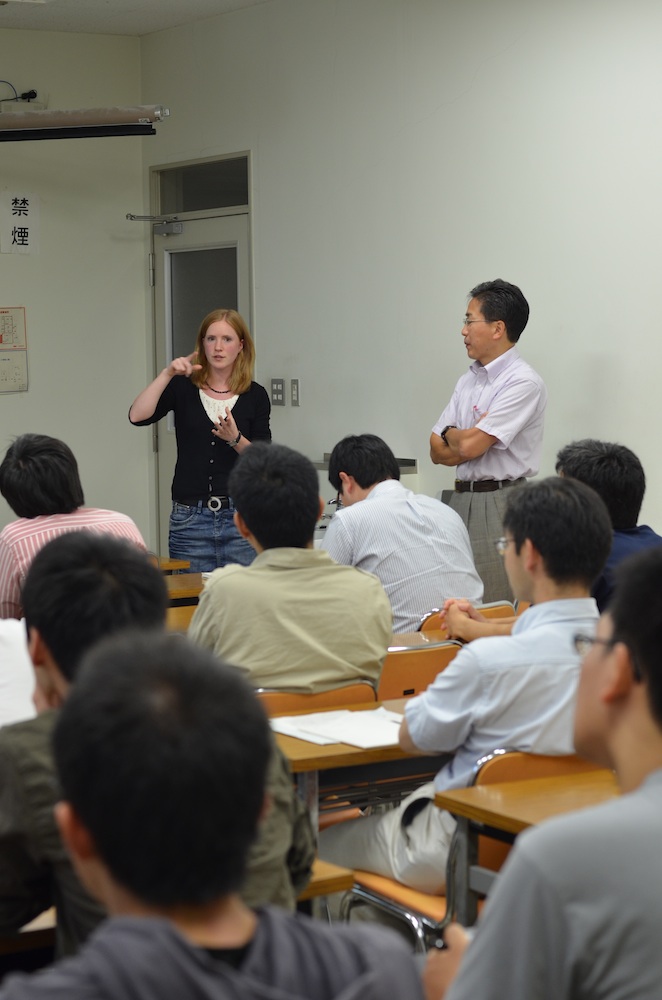「パリティの自発的破れがもたらす特異な電子状態」
楠瀬 博明氏
Feb 14, 2014
日本物理学会北海道支部講演会
トポロジー理工学教育研究センター第197回エンレイソウの会共催
講演題目: パリティの自発的破れがもたらす特異な電子状態
講 師 : 楠瀬 博明氏
愛媛大学大学院理工学研究科 准教授
日 時 : 平成26年2月14日 (金) 16:30-18:00
場 所 : 北海道大学理学部5号館206室(5-2-06)
要 旨 :
空間・時間反転対称性は固体中の電子状態の性質を強く制限している。 これらの自発的な破れが発生すれば、通常の磁性体のように、新しい物性を生み出すと期待される。 特に、スピン軌道相互作用がある系では、磁気と電気の間の非対角な応答が発生する。 本講演では、蜂の巣格子のような交替的に反転対称性のない系に着目して、反強磁性などの秩序が 空間反転対称性の自発的破れを誘発すること、その結果、生じる反対称スピン軌道相互作用もしくは 反対称スカラー場が電気磁気効果やスピン伝導などの非対角な応答に特異な影響を及ぼすこと、 を紹介する。特に、蜂の巣格子における2軌道ミニマル模型の解析結果を中心に議論したい。
世話人 柳澤達也
(tatsuya@phys.sci.hokudai.ac.jp)
北海道大学大学院理学研究院物理学部門
"Towards Bulk 49K Superconductivity in the Intermetallic CaFe2As2"
Mr. Tyler Drye
Nov 18, 2013
日本物理学会北海道支部講演会
トポロジー理工学教育研究センター第195回エンレイソウの会共催
講演題目: Towards Bulk 49 K Superconductivity in the Intermetallic CaFe2As2
講 師 : Mr. Tyler Drye
Department of Physics, University of Maryland College Park
(Visiting scholar by ICMR International Research Fellowship)
日 時 : 平成25年11月18日 (月) 15:00-16:00
場 所 : 北海道大学理学部2号館409室(2-4-09)
要 旨 :
The highest achievable superconducting critical temperature (Tc) in intermetallic iron-pnictide superconductors (specifically, the 122 family) was heald to be 39K when K is substituted for Ba in BaFe2As2. Our group was among the first to report traces of superconductivity in the 40-50K range when rare earth elements are doped for Ca in CaFe2As2. Unfortunately, these materials display a drastically low shielding volume fraction and correspondingly low critical current densities. Recent studies aimed at increasing this volume fraction, including high pressure synthesis and unusual doping schemes, have met with varying levels of success. This talk will detail these efforts and the outlook for bulk superconductivity in this system.
世話人 柳澤達也
(tatsuya@phys.sci.hokudai.ac.jp)
北海道大学大学院理学研究院物理学部門
 |
 |
「メゾスコピック超伝導体におけるボルテックダイナミクス」
宇治 進也 氏
Oct 23, 2013
北大理学部物理学部門主催、日本物理学会北海道支部講演会・ 第194回エンレイソウの会共催
講演題目: メゾスコピック超伝導体におけるボルテックダイナミクス
講 師 : 宇治 進也 氏
物質・材料研究機構 超伝導物性ユニット ユニットリーダー
日 時 : 平成25年10月23日 (水) 16:30-17:30
場 所 : 北海道大学理学部2号館211室(2-2-11)
要 旨 :
超伝導性を特徴づけるコヒーレンス長や磁場侵入長が、試料サイズと同程度になるメゾスコピック超伝導体では、試料の形状・境界条件が超伝導状態に大きく影響を与え(サイズ効果)、バルクの試料とは異なったメゾスコピック系特有の振る舞いが観測される。金属アルミニウムはバルクでは第一種の超伝導体であるが、 微小構造体では、そのサイズ効果により、第二種の超伝導体のように振る舞い、磁場中でボルテックス状態が形成される。電流を流すと、ボルテックスが駆動され、そこでエネルギーが散逸する。バルクでは、この散逸による抵抗は常伝導状態での抵抗を超えることはあり得ない。しかしメゾスコピック試料では、常伝導状態での抵抗の8倍もの大きさになることもあり、これには特異的なボルテックスのダイナミクスが関係している。この実験的な検証とメカニズムについて議論したい。
世話人 松永悟明
北海道大学大学院理学研究院物理学部門
【支部会からのお知らせ(運営について)】
Oct 01, 2013
1.北海道支部費として、学会事務局に予算請求した額が(年間約10万円)支給されます。 主な支出は支部講演会謝金、支部委員会開催時の旅費、通信文房具費、支部会事務謝金(1万円)です。2.道支部講演会は次の要領で行っています。
・講演の計画は、会員皆様への連絡の都合上、原則として一ヶ月前までに、講演者の略歴紹介および講演内容を添えて 支部三役まで連絡下さい。支部の行事として適切かどうか検討させて頂くことになっています。いうまでもなく、講演会は北大以外の他機関でも行うことが出来ます。
・支部講演会謝金は(基本的に)一律1万円です。(著名な講演者の場合はこの通りではありません)ただし、共催の形をとる場合、総額が1万円を超えない範囲で支出いたします。
・講演会申し込みは先着順とし、その年度の支部費がなくなった時点で打ち切ります。
・講演会の会員へのアナウンスは電子メールでアナウンスしますのでアナウンスの原稿を電子メールでWeb担当までお送りください。
3.通常の支部費のほかに支部活動を助成するために「支部活動助成費」が、物理学会本部で計上されています。非会員のための啓蒙的な特別講演会など様々な企画に対して先着順に利用できます。是非、ご利用下さい。
4.学会誌についてのご意見や掲載したい話題、記事、論文などがありましたら学会誌編集委員へ是非御一報下さい。
5.支部活動を開かれたものとし、かつ、活性化するために本ホームページを是非ご利用ください。
"Magnetic and transport properties of MnSi thin films"
Ms. Josefin Engelke
Sep 19, 2013
トポロジー理工学教育研究センター第192回エンレイソウの会 ・ 物理学会北海道支部講演共催
講演題目: Magnetic and transport properties of MnSi thin films
講 師 : Ms. Josefin Engelke
Technische Universitat Braunschweig, Institute for Condensed Matter Physics, 38106 Braunschweig, Germany
日 時 : 平成25年9月19日 (木) 15:00-16:00
場 所 : 北海道大学理学部2号館211室(2-2-11)
要 旨 :
MnSi offers a variety of different magnetic phases. The competition of ferromagnetic exchange with the Dzyaloshinskii-Moriya interaction causes a helical spin structure as the ground state of the system. In applied magnetic fields a conical structure and ferromagnetic spin alignment can be observed. In addition, a skyrmion lattice phase occurs in a small field and temperature region close to the ordering temperature, which is known as the A-phase. In thin films a larger skyrmionic phase is expected in the magnetic phase diagram due to surface effects and strain. Using molecular beam epitaxy MnSi thin films have been grown on Si(111) substrates. Magnetization and magnetoresistivity measurements have been carried out and related to the magnetic phase diagram. The magnetic ordering temperature T_ord is enhanced and shows a thickness dependence. In comparison to bulk MnSi also the critical magnetic fields of the thin films are enhanced. Furthermore several features can be identified occuring in the magnetization as well as in the magnetoresistivity measurements, which are not present in bulk material. Potentially these are indications of an enlarged skyrmionic phase.
Reference: "Spin-spin correlation length in MnSi thin film", J. Engelke, T. Reimann, L. Hoffmann, S. Gas, S. Sullow, D. Menzel, J. Phys. Soc. Jpn. 81 (2012) 124709.
世話人 網塚 浩
(amiami@phys.sci.hokudai.ac.jp)
北海道大学大学院理学研究院物理学部門
 |
 |




